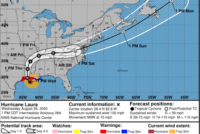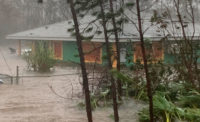After a rapid progression from Category 2 to Category 4 over just two days, Hurricane Laura made landfall near Cameron, La., about 1 a.m. CDT on Aug. 27 with sustained winds of 150 mph—the most powerful storm to ever make landfall in Louisiana, according to Louisiana Gov. John Bel Edwards. But the “unsurvivable” storm surge that many had predicted was not as high as anticipated.
“It is clear that we did not sustain and suffer the absolute catastrophic damage that we thought was likely based on the forecast that we had last night. But, we have sustained a tremendous amount of damage,” Edwards said during a press conference Aug. 27.
Some of the immediate damage included a chlorine gas chemical fire in Westlake La., which resulted in a shelter in place order for residents there and in Moss Bluff, La. Also, the nearby Isle of Capri riverboat casino came loose during the storm and became wedged underneath an I-10 bridge over the Calcasieu River.
“The bridge remains closed, so that means I-10 is closed, and that’s until we can do an inspection to see what sort of damage if any was caused by that barge,” Edwards said.
Meanwhile, firms are still trying to assess damage from Laura's arrival. Contractors ENR reached in eastern Louisiana did not have information to share as of Aug. 28. About 900,000 homes were without power the evening of Aug. 27 and more than 20,000 workers were helping to restore power. Entergy had instituted rolling blackouts in parts of southeast Texas on Aug. 27 to ensure the integrity of its unaffected power transmission line and to help with the power losses sustained during the storm. Those outages were cancelled early Friday morning. The utility reported that Laura caused “significant damage to Entergy’s electrical system across the state ... to transmission infrastructure, utility poles and power lines.”
Baton Rouge-based Turner Industries has 4,000 people working in the Lake Charles area at multiple facilities, and while the full extent of damage remains unknown, its people and main office are okay, according to President Stephen Toups.
Several firms confirmed that it wouldn't be until sometime next week that damage assessments could be completed.
Perhaps the biggest surprise was that the storm surge of 20 ft or more experts predicted didn’t materialize.
“I think we were somewhat—I don't want to say lucky because again, no, hurricane is a good thing—but I think the storm surge was only about 11 ft, which is still, you know, not great, but certainly better than the 20 ft that was expected," Suzanne Lemieux, manager of operations, security and emergency response for the American Petroleum Institute, noted during a call. "I think the storm, while still significant, actually spared a lot of infrastructure.”
Lemieux said API is “still waiting and hoping that the infrastructure and the communities in which we're operating in Louisiana and far East Texas has not been significantly impacted by Hurricane Laura.”
The oil and gas industry made “significant” preparations before Laura hit—which began in response to the pending threat of Tropical Storm Marco last week—“evacuating people from offshore facilities, shutting in refineries and taking the steps that are necessary to protect those assets and infrastructure from potential hurricane damage,” Lemieux said.
The federal Bureau of Safety and Environmental Enforcement estimated Aug. 27 that approximately 84.3% of the current oil production in the Gulf of Mexico has been shut down, along with 60.1% of natural gas production.
Edwards noted the presence of tropical storm force winds in the entire state. Several outer bands of the storm reached out as far as Corpus Christi, Texas.
“It just shows what a huge geographic area these storms can have an influence over. These bands have huge potential to cause damage,” notes Jim Blackburn, co-director of the Severe Storm Prediction, Education and Evacuation from Disaster (SSPEED) Center at Rice University in Houston.
“I think just almost across the board, we really dodged a huge bullet on this storm,” Blackburn says. “This was a very spooky storm in that it intensified so quickly and had it not jogged back up to go into the Texas-Louisiana border. Had it come on into the Houston area, we're totally unprepared for a large storm like that with surge.”
Gov. Edwards indicated that search and rescue is a priority for the state right now, and that once that process is over, officials will begin preparing damage assessments.
“I think that vulnerability does not seem to be penetrating the people that are in charge. I think we've got to plan for category 5 storms,” Blackburn says, noting the warmer waters that can intensify storms. “I think the days where we have the luxury of a category 5 being a very rare event are over. This one was a cat 4 overnight, but this was not a hurricane that came across the Atlantic.”
In the years since Hurricane Harvey, the SSPEED Center has continued working on its multiple lines of defense strategy to provide storm surge protection to Galveston and Houston. The in-bay portion of that, the Galveston Bay Park Plan, proposes the construction of a new string of islands in Galveston Bay that will double as a storm surge barrier and recreational park space. The project will be a combination of ship channel widening, dredging, recreation and environmental enhancement, Blackburn says.






Post a comment to this article
Report Abusive Comment